Papers by Muhammad Jadoon
Eye, 2001
Purpose To assess the prevalence of visual impairment and the underlying causes in a popUlation o... more Purpose To assess the prevalence of visual impairment and the underlying causes in a popUlation of people with diabetes. Method A population-based study of a defined population of people with diabetes in a district in the North West of England was done. There were 7652 known people with diabetes, representing 2.12% of target general population of 361 050. The main outcome measures were the prevalence of blindness and significant visual impairment (less than
JAMA Ophthalmology, Nov 17, 2022

Ophthalmic Epidemiology, 2008
To determine the prevalence of refractive error (RE) and spectacle wear and to explore the need f... more To determine the prevalence of refractive error (RE) and spectacle wear and to explore the need for spectacle correction in adults (30 years or older) in Pakistan. Multi-stage, cluster random sampling national survey. Each subject had their medical history taken, visual acuity measured, and underwent autorefraction, biometry and fundus examination. Those that presented with visual acuity of less than 6/12 in either eye underwent more detailed examination, including corrected distance visual acuity measurement (autorefraction results placed in a trial lens frame). Myopia was defined as a spherical equivalent of worse than -0.5D, hypermetropia as greater than +0.5D, and astigmatism as greater than 0.75D. Spectacle need (i.e., those that improved from unaided VA with spectacle correction) was determined along with the spectacle coverage, defined as the proportion of need that was met (by the participant's own spectacles). The crude prevalence of myopia, hypermetropia and astigmatism was 36.5%, 27.1%, and 37%, respectively. The prevalence of spectacle wear in phakic participants was 4.0%, significantly lower than for those who were pseudo/aphakic (41.7%). Just over a quarter (25.8%) of spectacle wearers presenting with visual impairment (< 6/12) were able to improve their vision when retested with their autorefraction prescription. The overall spectacle coverage (6/12 cutoff) was 15.1%. This survey provides the first reliable national estimates. RE services are not covering the majority of the population in need and the provision of spectacle correction, as a highly cost effective treatment for visual impairment, needs addressing within the…
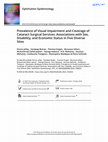
Ophthalmic Epidemiology
Purpose: Prevalence of visual impairment (VI) and access to services can vary significantly acros... more Purpose: Prevalence of visual impairment (VI) and access to services can vary significantly across and between different population groups. With renewed focus on universal health coverage and leaving no one behind, it is important to understand factors driving inequitable eye health. This paper presents results from five population-based surveys where prevalence of VI and cataract surgical coverage (CSC) were measured and examined for differences by sex, economic-status, and disability. Methods: Rapid assessments of avoidable blindness took place in four rural sites: Kalahandi, Jhabua and Sitapur in India; and Singida, Tanzania; and one urban site: Lahore, Pakistan. In addition, the Equity Tool was used to measure economic status and the Washington Group Short Set was used to measure disability. Prevalence of VI and CSC were calculated and associations with sex, disability, and relative wealth examined. Results: Prevalence of VI varied from 1.9% in Lahore to 15.0% in Kalahandi. CSC varied from 39.1% in Singida to 84.0% in Lahore. Additional disability was associated with greater levels of VI in all sites and lower CSC in Singida. Being female was associated with higher VI in Kalahandi, Lahore and Singida and lower CSC in Lahore and Singida. Being poorer was associated with higher VI in Singida and lower CSC in Singida and Sitapur. Conclusion: Relationships between VI and relative wealth, sex, and disability are complex and variable. Although certain characteristics may be associated with lower coverage or worse outcomes, they cannot be generalized and local data are vital to tailor services to achieve good coverage.
Ophthalmic Epidemiology, 2007
Investigative Ophthalmology Visual Science, Nov 1, 2006
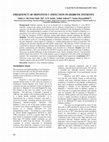
Journal of Ayub Medical College, Abbottabad : JAMC
Diabetic patients are at an increased risk of acquiring Hepatitis C virus (HCV) infection owing t... more Diabetic patients are at an increased risk of acquiring Hepatitis C virus (HCV) infection owing to the nature of the disease and its inherent complications or frequent parentral exposure. On the other hand HCV infection may itself contribute to the development of Diabetes Mellitus. The epidemiological evidence of this association has not been studied in Pakistan at a population level and its exact biological mechanisms are not obvious. Objective of this study was to study the frequency of HCV infection among adult diabetic patients attending the Hospital. The study comprised of 100 Diabetic patients visiting the out patient clinics or admitted in the medical wards of a Teaching Hospital, in Peshawar. Diabetes was confirmed according to the new diagnostic criteria based on 2 fasting or 2 random plasma glucose levels of more than 126 milligram per deciliter (mg/dL) and 200 mg/dL respectively. The presence of HCV infection was confirmed by Enzyme Linked Immuno-Sorbent Assay (ELISA) met...
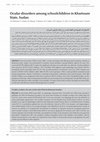
Eastern Mediterranean health journal = La revue de santé de la Méditerranée orientale = al-Majallah al-ṣiḥḥīyah li-sharq al-mutawassiṭ, 2013
From December 2005 to June 2007, a total screening of all 1418 government primary schools in Khar... more From December 2005 to June 2007, a total screening of all 1418 government primary schools in Khartoum State, Sudan, was performed to estimate ocular problems among children aged 6-15 years. We screened 671,119 children (56.7% males) for significant refractive error and other eye ailments. Ocular problems were found in 20,321 (3.03%) children. The 3 localities with highest ocular pathology were Karary (26.2%), Ummbada (21.0%) and Jabal Awlia (15.7%). The overall prevalence of refractive error was 2.19%. Myopia was found in 10,064 (1.50%) children while 4661 (0.70%) were hyperopic. Other ocular problems included vernal keratoconjunctivitis, vitamin A deficiency, microbial conjunctivitis, strabismus and corneal opacity. Only 288 (0.04%) children were diagnosed with active trachoma: 86.5% of these were from Ummbada locality, on the periphery ofthe State, where transportation facilities are poor and poverty is widespread. Overall, 99% of the eye ailments identified are either treatable o...
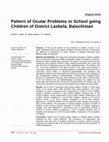
Purpose: To find out the pattern of eye problems in children of age 6 to 15 years, attending scho... more Purpose: To find out the pattern of eye problems in children of age 6 to 15 years, attending schools and madaris (religious schools) and also to determine the difference in prevalence of ocular disease in students attending these different types of institutions. Material and Methods: The study was conducted in Madaris of district Lasbela were screened from February 2008 to September 2009. All students of schools / madaris of district Lasbela were included in the study. The visual acuity (VA) was measured using standard Snellen's chart; external examination was carried out with the help of magnifying loop and direct ophthalmoscope. The children with VA < 6/12 were refracted to the best correction. The study team included a community ophthalmologist, an ophthalmologist, an ophthalmic technician and a community social worker. A structured questionnaire was prepared and operational methods were field tested and refined by piloting at the outpatient of Isra Postgraduate Institute ...
Two hundred and two indoor patients were interviewed and duration of diabetes, drugs taken for th... more Two hundred and two indoor patients were interviewed and duration of diabetes, drugs taken for the control of diabetes, history of any previous eye examination was recorded. Later dilated fundoscopy was done by endocrinologist and finally all the patients were sent for independent assessment by an ophthalmologist for categorizing DR and if needed laser was done for the affected eyes. Of 202 patients only 9(4%) patients had optimum diabetic control with HbA C of <7. Ninety four 1 (47%) had previous eye examination while 108(53%) had never had their eyes examined. Of those examined 77(81.9%) had been seen by ophthalmologist, 13(13.8%) by physician/endocrinologist and only 4(4.3%) by general practitioners (G.Ps). Dilated fundoscopy showed 118(58%) patients had retinopathy. Thirty eight (18.8%) patients were offered laser treatment after appropriate investigations.
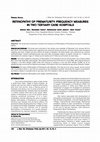
Objective: The study was conducted to measure the frequency of Retinopathy of Prematurity among t... more Objective: The study was conducted to measure the frequency of Retinopathy of Prematurity among the premature babies. Material and Methods: Material and Methods: Material and Methods: Material and Methods: Material and Methods: This study was conducted in two tertiary care hospitals of Peshawar, from January 2010 to April 2010. One hundred babies were registered and examined during the period. All these babies were premature weighing less than 1750gm and born before 35 weeks of gestation. All these babies were examined by a trained ophthalmologist. Indirect ophthalmoscopy was done after cycloplegic dilation at regular intervals as 1 st follow up examination at 4 weeks of age, 2 nd follow up at 6 weeks and 3 rd follow up at 8 weeks on each baby. Results: Results: Results: Results: Results: 100 cases registered, frequency of Retinopathy of Prematurity found 0% among them. Out of these infants 68% were male while 32% were female, 79% infants examined from KTH and 21% from HMC. 66% infants belong to category I Low Birth Weight (LBW) while 34% belong to category II very low Birth Weight (VLBW) as for as gestational age concerned the highest percentage of the babies came from gestational age group 32weeks+6days. Conclusion: Conclusion: Conclusion: Conclusion: Conclusion: No case of Retinopathy of Prematurity was detected. This may be of so many causes, as the survival rate of premature births is very less as compared to the developed countries. Secondly the oxygen concentration provided to babies in neonatal units is very less, 50%-70% instead to 100% as given in developed countries.

Ophthalmic Epidemiology, 2005
To establish age- and sex-specific prevalence rates and causes of blindness and low vision in chi... more To establish age- and sex-specific prevalence rates and causes of blindness and low vision in children aged 10 to 15 years and adults aged 30 years and older in Pakistan. Multi-stage, stratified (rural/urban), cluster random sampling, with probability proportional-to-size procedures, was utilised to select a cross-sectional, nationally representative sample of adults (16,600 subjects) and children (6,000 subjects). Each subject underwent: interview, visual acuity (logMAR), autorefraction and optic disc examination. Those that saw &amp;amp;amp;amp;amp;amp;amp;amp;amp;amp;amp;amp;amp;amp;amp;amp;amp;amp;amp;amp;amp;amp;amp;amp;amp;amp;amp;amp;amp;amp;amp;amp;amp;amp;amp;amp;amp;amp;amp;amp;amp;amp;amp;amp;amp;amp;amp;amp;amp;amp;amp;amp;amp;amp;amp;amp;amp;amp;amp;amp;amp;amp;amp;amp;amp;amp;amp;amp;amp;amp;amp;amp;amp;amp;amp;amp;amp;amp;amp;amp;amp;amp;amp;amp;amp;amp;amp;amp;amp;amp;amp;amp;amp;amp;amp;amp;amp;amp;amp;amp;amp;amp;amp;amp;amp;amp;amp;amp;amp;amp;lt; 6/12 in either eye underwent corrected visual acuity and dilated posterior segment examination. The results of a pilot survey are reported in this paper. In the two rural pilot sites, 159 subjects (including 47 children) were examined; 50% were male. Thirty seven adults (23.3%) but no children saw worse than 6/12 in either eye. Two subjects were blind (corrected visual acuity) in the better eye, and 11 were visually impaired. Refractive error was the main cause (in 22 eyes (39% of the total of 56 eyes)) of &amp;amp;amp;amp;amp;amp;amp;amp;amp;amp;amp;amp;amp;amp;amp;amp;amp;amp;amp;amp;amp;amp;amp;amp;amp;amp;amp;amp;amp;amp;amp;amp;amp;amp;amp;amp;amp;amp;amp;amp;amp;amp;amp;amp;amp;amp;amp;amp;amp;amp;amp;amp;amp;amp;amp;amp;amp;amp;amp;amp;amp;amp;amp;amp;amp;amp;amp;amp;amp;amp;amp;amp;amp;amp;amp;amp;amp;amp;amp;amp;amp;amp;amp;amp;amp;amp;amp;amp;amp;amp;amp;amp;amp;amp;amp;amp;amp;amp;amp;amp;amp;amp;amp;amp;amp;amp;amp;amp;amp;amp;lt; 6/12 visual acuity, followed by cataract (12 eyes), uncorrected aphakia (6 eyes) and age-related macular disease (3 eyes). The pilot survey demonstrated that the proposed examination process for the main survey is feasible. Particular strengths of this survey include the use of logMAR visual acuity testing and autorefraction of all subjects, a dilated posterior segment examination, and the use of a &amp;amp;amp;amp;amp;amp;amp;amp;amp;amp;amp;amp;amp;amp;amp;amp;amp;amp;amp;amp;amp;amp;amp;amp;amp;amp;amp;amp;amp;amp;amp;amp;amp;amp;amp;amp;amp;amp;amp;amp;amp;amp;amp;amp;amp;amp;amp;amp;amp;amp;amp;amp;amp;amp;amp;amp;amp;amp;amp;amp;amp;amp;amp;amp;amp;amp;amp;amp;amp;amp;amp;amp;amp;amp;amp;amp;amp;amp;amp;amp;amp;amp;amp;amp;amp;amp;amp;amp;amp;amp;amp;amp;amp;amp;amp;amp;amp;amp;amp;amp;amp;amp;amp;amp;amp;amp;amp;amp;amp;amp;#39;less than 6/12&amp;amp;amp;amp;amp;amp;amp;amp;amp;amp;amp;amp;amp;amp;amp;amp;amp;amp;amp;amp;amp;amp;amp;amp;amp;amp;amp;amp;amp;amp;amp;amp;amp;amp;amp;amp;amp;amp;amp;amp;amp;amp;amp;amp;amp;amp;amp;amp;amp;amp;amp;amp;amp;amp;amp;amp;amp;amp;amp;amp;amp;amp;amp;amp;amp;amp;amp;amp;amp;amp;amp;amp;amp;amp;amp;amp;amp;amp;amp;amp;amp;amp;amp;amp;amp;amp;amp;amp;amp;amp;amp;amp;amp;amp;amp;amp;amp;amp;amp;amp;amp;amp;amp;amp;amp;amp;amp;amp;amp;amp;#39; threshold for further examination. This lower threshold addresses the burden of refractive error, which, with cataract, are two of the diseases specifically targeted by Vision 2020.
Ophthalmic Epidemiology, 2007
Purpose: To investigate the prevalence and risk factors for lens opacity (LO) amongst a nationall... more Purpose: To investigate the prevalence and risk factors for lens opacity (LO) amongst a nationally representative sample of the adult population of Pakistan. Methods: This national study of blindness and visual impairment (adults ≥30 years) used multistage, stratified, cluster random sampling. Grading of LO was conducted using the Mehra/Minassian classification system. LO, partly or wholly obscuring the red reflex, or previous cataract surgery were indicators of opacity. Results: 16,402 (94.7%) adults were included in this analysis (study conducted 2002-2003). A total of 4,096 (standardized prevalence 20.9%, 95%CI: 20.3, 21.5%) adults were found to have LO. The highest prevalence of LO was found in Punjab province (22.2%), the lowest in Balochistan Province (18.0%). Significant positive associations were increasing age (multivariable odds ratio (OR) 3.
Ophthalmic Epidemiology, 2008
and-conditions-of-access.pdf This article may be used for research, teaching and private study pu... more and-conditions-of-access.pdf This article may be used for research, teaching and private study purposes. Any substantial or systematic reproduction, redistribution , reselling , loan or sub-licensing, systematic supply or distribution in any form to anyone is expressly forbidden. The publisher does not give any warranty express or implied or make any representation that the contents will be complete or accurate or up to date. The accuracy of any instructions, formulae and drug doses should be independently verified with primary sources. The publisher shall not be liable for any loss, actions, claims, proceedings, demand or costs or damages whatsoever or howsoever caused arising directly or indirectly in connection with or arising out of the use of this material.
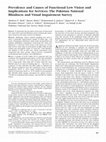
Investigative Ophthalmology & Visual Science, 2008
Group 4 PURPOSE. To determine the prevalence and causes of functional low vision (FLV) and total ... more Group 4 PURPOSE. To determine the prevalence and causes of functional low vision (FLV) and total blindness and to estimate the assessment needs for low-vision services in Pakistan. METHODS. Multistage, cluster random sampling was used to select a nationally representative sample of adults (age, Ն30 years). Participants underwent visual acuity measurement and detailed ophthalmic examination. Functional low vision was defined as a corrected visual acuity in the better eye of less than 6/18 to more than no perception of light (NPL) in individuals with untreatable causes of visual loss. Total blindness was defined as NPL in both eyes. Needs assessments were categorized into three groups: optical services, nonoptical/ environmental interventions, and rehabilitation. RESULTS. A sample of 16,507 adults (95.3% response rate) was examined. The standardized prevalence of FLV and total blindness were 1.7% (95% CI: 1.5%-1.9%) and 0.2% (95% CI: 0.1%-0.2%), respectively. More than 90% of those with FLV were illiterate and 35.3% were of working age (i.e., Ͻ60 years). An estimated 727,000 (586,000-891,000) adults in Pakistan had FLV. Retinal conditions were the commonest cause in urban populations (39.8% vs. 26.5% rural) compared with corneal opacity in rural areas (38.0% vs. 25.5% urban). It was estimated that 565,000 adults require assessment for optical services, 735,000 for nonoptical interventions, and 424,000 for rehabilitation. CONCLUSIONS. As VISION 2020 enters its second 5-year phase, the provision of low-vision services and their integration into national eyecare programs is a priority. In Pakistan, planning must take account of the magnitude along with the demographic and educational characteristics of those affected. (In
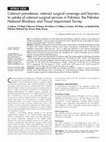
British Journal of Ophthalmology, 2007
To estimate the prevalence of visual impairment and blindness caused by cataract, the prevalence ... more To estimate the prevalence of visual impairment and blindness caused by cataract, the prevalence of aphakia/pseudophakia, cataract surgical coverage (CSC) and to identify barriers to the uptake of cataract services among adults aged >30 years in Pakistan. Methods: Probability proportional-to-size procedures were used to select a nationally representative sample of adults. Each subject underwent interview, visual acuity measurement, autorefraction, biometry and ophthalmic examination. Those that saw ,6/12 in either eye underwent a more intensive examination procedure including corrected visual acuity, slit lamp and dilated fundus examination. CSC was calculated for different levels of visual loss by person and by eye. Individuals with ,6/60 in the better eye as a result of cataract were interviewed regarding barriers. Results: 16 507 Adults were examined (95.5% response rate). The crude prevalence of blindness (presenting ,3/60 in the better eye) caused by bilateral cataract was 1.75% (95% CI 1.55%, 1.96%). 1317 Participants (633 men; 684 women) had undergone cataract surgery in one or both eyes, giving a crude prevalence of 8.0% (95% CI 7.6%, 8.4%). The CSC (persons) at ,3/60, ,6/60 and ,6/18 were 77.1%, 69.3% and 43.7%, respectively. The CSC (eyes) at ,3/60, ,6/60 and ,6/18 were 61.4%, 52.2% and 40.7%, respectively. Cost of surgery (76.1%) was the main barrier to surgery. Conclusion: Approximately 570 000 adults are estimated to be blind (,3/60) as a result of cataract in Pakistan, and 3 560 000 eyes have a visual acuity of ,6/60 because of cataract. Overall, the national surgical coverage is good but underserved populations have been identified.
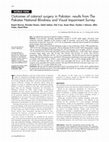
British Journal of Ophthalmology, 2007
To evaluate the outcomes of cataract surgery in Pakistan. Methods: Cross-sectional, nationally re... more To evaluate the outcomes of cataract surgery in Pakistan. Methods: Cross-sectional, nationally representative sample of 16 507 adults (aged >30 years). Each underwent interview, logarithm of the minimum angle of resolution visual acuity (VA), autorefraction, examination of optic disc. Those with ,6/12 VA on presentation underwent best-corrected VA and dilated biomicroscopic ocular examination. Results: 1317 subjects (633 men) had undergone surgery in one or both eyes. Of the 1788 operated eyes, 1099 (61%) had undergone intracapsular cataract extraction (ICCE) and 607 (34%) extracapsular surgery with an intraocular lens (ECCE+IOL). Presenting VA: 275 (15.4%) eyes: 6/12 or better; 253 (14.1) ,6/12 >6/18; 632 (35.3%) 6/18 to 6/60; 85 (4.8%): 6/60 to 3/60; 528 (29.5%): ,3/60. With ''best'' refractive correction, these values were: 563 (31.5%), 332 (18.6%), 492 (27.5%), 61 (3.4%), 334 (18.7%), respectively. Of the 1498 eyes with VA (6/12 on presentation, 352 (23.5%) were the result of coincident disease, 800 (53.4%) refractive error and 320 (21.4%) operative complications. Eye camp surgery (OR 1.72, p = 0.002), ICCE (OR 3.78; p,0.001), rural residence (OR 1.36, p = 0.01), female gender (OR 1.55, p,0.001) and illiteracy (OR 2.44, p,0.001) were associated with VA of ,6/18. More recent ICCE surgeries were associated with a poorer outcome. The ratio of ECCE+IOL:ICCE in the last 3 years was 1.2:1, compared with 1:3.3 >4 years before the survey. Conclusion: Almost a third of cataract operations result in a presenting VA of ,6/60, which could be halved by appropriate refractive correction. This study highlights the need for an improvement in quality of surgery with a more balanced distribution of services.
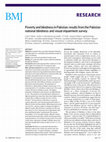
BMJ, 2008
Objective To explore the association between blindness and deprivation in a nationally representa... more Objective To explore the association between blindness and deprivation in a nationally representative sample of adults in Pakistan. Design Cross sectional population based survey. Setting 221 rural and urban clusters selected randomly throughout Pakistan. Participants Nationally representative sample of 16 507 adults aged 30 or above (95.3% response rate). Main outcome measures Associations between visual impairment and poverty assessed by a cluster level deprivation index and a household level poverty indicator; prevalence and causes of blindness; measures of the rate of uptake and quality of eye care services. Results 561 blind participants (<3/60 in the better eye) were identified during the survey. Clusters in urban Sindh province were the most affluent, whereas rural areas in Balochistan were the poorest. The prevalence of blindness in adults living in affluent clusters was 2.2%, compared with 3.7% in medium clusters and 3.9% in poor clusters (P<0.001 for affluent v poor). The highest prevalence of blindness was found in rural Balochistan (5.2%). The prevalence of total blindness (bilateral no light perception) was more than three times higher in poor clusters than in affluent clusters (0.24% v 0.07%, P<0.001). The prevalences of blindness caused by cataract, glaucoma, and corneal opacity were lower in affluent clusters and households. Reflecting access to eye care services, cataract surgical coverage was higher in affluent clusters (80.6%) than in medium (76.8%) and poor areas (75.1%). Intraocular lens implantation rates were significantly lower in participants from poorer households. 10.2% of adults living in affluent clusters presented to the examination station wearing spectacles, compared with 6.7% in medium clusters and 4.4% in poor cluster areas. Spectacle coverage in affluent areas was more than double that in poor clusters (23.5% v 11.1%, P<0.001). Conclusion Blindness is associated with poverty in Pakistan; lower access to eye care services was one contributory factor. To reduce blindness, strategies targeting poor people will be needed. These interventions may have an impact on deprivation in Pakistan.
jpmi.org.pk
This cross-sectional observational study was conducted at Department of Diabetes, Endocrinology a... more This cross-sectional observational study was conducted at Department of Diabetes, Endocrinology and Metabolic diseases, Postgraduate Medical Institute, Hayatabad Medical Complex Peshawar. Two hundred and two, indoor diabetic patients during one-year duration of ...
Uploads
Papers by Muhammad Jadoon